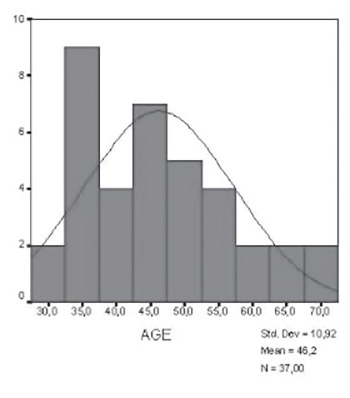Check List of Symptoms SCL - 90 - R at Persons with Extremities Amputations
DOI:
https://doi.org/10.17305/bjbms.2006.3212Keywords:
amputation, SCL-90-r, physical traumaAbstract
Multidimensional Inventory Check List of Symptoms (SCL-90-r) is based on self-evaluation and it has been used for determination of level of: somatisation, obsessive-compulsive symptoms, interpersonal sensitivity, depression, anxiety, hostility, phobias, paranoia and psychosis at persons which are exposed to long term emotional and physical stress. Our goal was to determine relations of physical trauma and psychological changes at persons with lower extremities amputations and to determine factors which influence those changes. Thirty seven persons with lower extremities amputations were examined. The sample included 26 (70.2 %) veterans and 11 (29.7 %) civilians with diseases related amputations. They voluntarily filled Check List of Symptoms SCL-90-r. Symptoms Inventory includes 9 dimensions of primary symptoms: SCL1-somatisation, SCL2-obsessive-compulsive symptoms, SCL3-interpersonal sensitivity, SCL4-depression, SCL5-anxiety, SCL6-hostility, SCL7-phobias, SCL8-paranoia, SCL9-psychosis and SCL10-extra scale. Inventory includes 90 statements, each evaluated with five-level scale of disorder. Every answer is graded with 0-4 points. Thirty seven persons with lower extremities amputations and average chronological age 46.2 +/- 10.92 years were analyzed. Considering marital status 30 (81.1 %) of them were married, 4 (10.8 %) were not married and 3 (8.1 %) were widowers. Considering level of amputation 27 of them (73.0 %) had amputation below knee, 5 (13.5 %) of them amputation above knee and 5 of them (13.5 %) foot amputation. SCL-90-r in both groups determined high level of sensitivity, anxiety, hostility and paranoia. Veterans showed higher level of paranoia comparing to civilians (p<0.002), and younger veterans and married ones had higher level of paranoia comparing to other veterans (p<0.01). Persons with amputations below and above knee showed higher level of paranoia comparing those with foot amputation (p<0.001). Persons with lower extremities amputations have considerably more expressed sensitivity, anxiety, hostility and paranoia. These dimensions are related to age, marital status and level of amputation. These determinants are very helpful for planning and creation of psychological support and rehabilitation of persons with lower extremities amputations.
Citations
Downloads

Downloads
Published
Issue
Section
Categories
How to Cite
Accepted 2018-02-19
Published 2006-02-20









